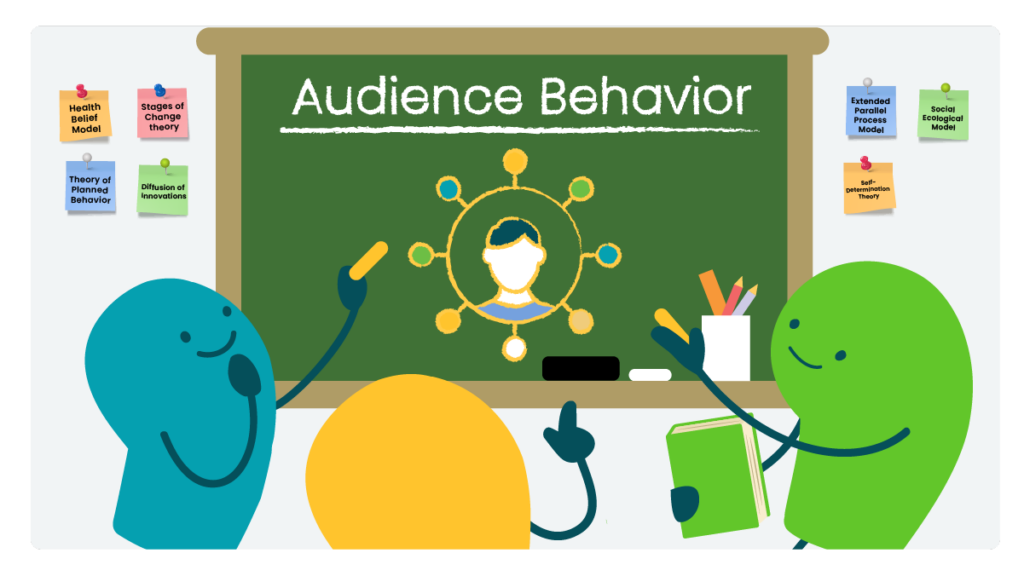
Here at We ❤️ Health Literacy Headquarters, we often turn to trusted theoretical models to help us understand how and why people change behaviors. Health communication theories provide a roadmap or blueprint for better understanding your audiences, the factors that influence them, and their behaviors. In practice, theory can help us identify or narrow down an audience, plan health information campaigns, and inform outreach strategy.
For today’s post, we’ve gathered a few of our favorite health behavior and health comm theories.
- Health Belief Model is one of the most widely used theories in the field of health comm. It explains how people’s beliefs about a disease can motivate them to take action to prevent, get screened for, or manage the disease. This includes how people think and feel about their risk of getting the disease, how serious it is, the benefits of taking action, and the barriers they might face. Understanding these beliefs can help you craft messages that address people’s concerns and motivate them to take steps to protect their health.
- Stages of Change theory (also known as the Transtheoretical Model) asserts that behavior change is a process, not an event. According to this theory, a person attempting to change a behavior moves through 5 stages: Precontemplation, Contemplation, Preparation, Action, and Maintenance. Recognizing what stage your audience is in can help you tailor messages and interventions to meet them where they are.
- Theory of Planned Behavior states that a person’s behavior depends on how they assess 3 factors: behavioral beliefs (What’s going to happen if I do this?), normative beliefs (What will others think about it?), and control beliefs (Am I going to be able to do it?). Using this model can help you design interventions that shift people’s intentions by addressing their beliefs, social norms, and perceived control.
- Diffusion of Innovations addresses how ideas, products, and social practices that are perceived as “new” spread throughout a society, or from one society to another. Understanding these dynamics can help you better promote your program or intervention.
- Extended Parallel Process Model explains that health risk messages tend to get people thinking about 2 things: threat and efficacy. According to this theory, how we perceive threat (How likely is it that something bad will happen?) and efficacy (Is there anything I can do to prevent it?) determines our health behaviors. This theory can help you create effective messages about health risks that get your audience’s attention and empower them to take action.
- Social Ecological Model says that successful health promotion addresses both individuals and their environments. That’s because we don’t live our lives — or make our health decisions — in a vacuum. Applying this model can help you design multi-level strategies that go beyond individual behavior change to include social and systemic supports.
- Self-Determination Theory is a framework for understanding what motivates people to make choices and change behaviors. It says that people are more likely to take action — and stick with it — when they feel autonomous (in control of their decisions), competent (capable of doing the behavior), and connected (supported by others). This theory can help you create programs that keep people motivated by making them feel in control, capable, and supported.
But how do you know which health comm theory is right for you? When choosing a theory to guide your work, start by thinking about your specific goals: Are you trying to raise awareness, shift attitudes, or change behavior? The right theory will help you understand the “why” behind your audience’s actions — and point you toward strategies that can make a difference. Consider factors like your audience’s readiness for change, the context in which they receive information, and the barriers they might face.
There’s no one-size-fits-all approach — and often, combining multiple theories or constructs from multiple theories can give you a more complete picture. The key is to choose a theory (or theories) that aligns with your project’s purpose and your audience’s needs.
The bottom line: Theories offer a powerful foundation for your health communication work — helping you understand your audience, shape your strategy, and inspire behavior change.
Copy/paste to share on social (and tag us!): Theory provides a roadmap for better understanding your audience, the factors that influence them, and their health behaviors. This week, CommunicateHealth highlights a few favorite #HealthComm theories: https://communicatehealth.com/wehearthealthliteracy/health-comm-theories-a-roundup/
Browse recent posts